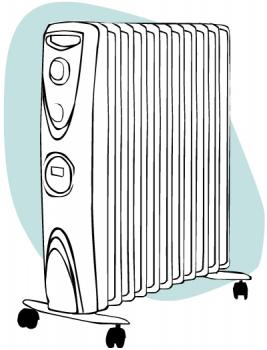
Oil-filled column heaters are portable electric units that typically come in either 1200W or 2400W varieties, differing most obviously in the number of columns they incorporate. Oil heaters are still used and valued for a number of reasons. While they take a while to warm up, they emit heat in all directions (albeit not very far), and they don't make any noise at all. They are also considered to be a safer option than many other types of heaters because they aren’t scalding hot, there’s no naked flame, and there's normally very little risk in leaving them on in a bedroom. For this reason they're also considered a safer option around small children.
How do oil-filled column heaters work?
Oil-filled column heaters work by immersing resistive electric elements in an oil-filled casing. As the electric elements are heated, heat is transferred from the elements to the oil, which in turn heats the column casings that contain it. The whole principle is very similar to the way in which an electric kettle works, with a metal coil at the base heating the water.
The oil retains heat longer than a less dense fluid like water might, so once the unit is switched off, it will remain hot and continue to emit heat for quite some time. Another reason these systems use oil rather than water or a similar liquid is that oil has a higher boiling point. This means that you won’t have any loss due to evaporation, or the substantial stress on the system due to increased pressure. It also means it can produce more heat than a water-based system, without needing to be refilled.
Oil filled column heaters produce radiant heat, but as air passes between the columns and fins of the heater, some convective heat is also produced.
How energy efficient are oil heaters?
Oil-filled column heaters are not very efficient in terms of the heat they produce and the large amounts of energy they use to do so. In fact, they're roughly on par with convective fan heaters in that respect.
|
Advantages
|
Disadvantages
|



